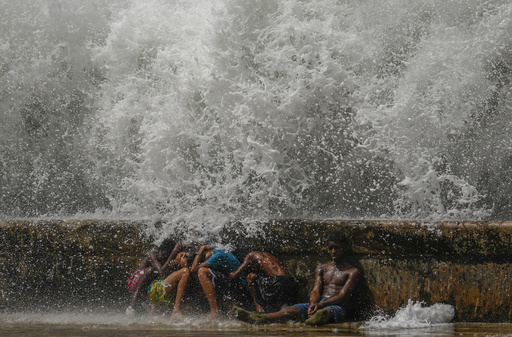Hurricane Milton has emerged as a formidable force, raising alarms among meteorologists due to its unprecedented rapid intensification.
This storm escalated from a minimal hurricane to a powerful Category 5 in less than a span of ten hours, further illustrating the chaotic and dangerous nature of its development.
Even after a period of weakening, Milton made a swift recovery and peaked with winds reaching 180 mph, alongside a barometric pressure that ranks among the lowest recorded in the Gulf of Mexico for this time of year.
Experts noted that during its peak intensity, Milton was on the verge of achieving its maximum potential based on existing weather conditions.
“All the elements you would expect for a storm to become extremely powerful were present with Milton,” commented Phil Klotzbach, a hurricane researcher from Colorado State University.
The storm’s unusual trajectory through the Gulf of Mexico is rare, with the last notable instance dating back to 1848.
The Tampa area, which represents the largest metropolitan population in Milton’s projected path, has not faced a direct strike from a significant storm in over a century.
This makes the current situation particularly alarming for meteorologists.
“This path is not unheard of, but it is quite unusual,” explained Brian McNoldy, a hurricane researcher from the University of Miami.
“Among those that have followed such a route, this is by far the most potent.”
Gabriel Vecchi, a climate scientist at Princeton University, stated, “This storm is likely to differ vastly from any other storm experienced along Florida’s west coast.”
However, storms of this nature may become more common amid the U.S.’s ongoing streak of severe weather incidents.
In the past eight years, the U.S. has experienced seven hurricanes classified as Category 4 or stronger, a significant increase compared to the historical annual average since 1950.
If Milton makes landfall as a Category 4 hurricane, it would mark the second instance of the U.S. being impacted by two such powerful hurricanes within a single year.
This follows a rare 12-year hiatus where no Category 4 or stronger storms made landfall across the mainland.
Kristen Corbosiero, an atmospheric scientist and hurricane expert at the University of Albany, remarked that the current threats posed by Milton are attributed to a combination of chance—given that past major storms did not land—and climate change influencing storm behaviors in new ways.
“The rise in the frequency and intensity of storms increases the likelihood of a major hurricane striking the U.S.,” she noted.
A significant portion of Milton’s explosive development is related to the warmer waters associated with climate change.
The storm originated in the Bay of Campeche, located in the southwestern Gulf of Mexico.
Initial forecasts were skeptical that the destabilized air mass would evolve into a tropical system, let alone a powerful hurricane.
However, once the storm formed, it thrived on the warm waters and avoided high-level wind currents that often inhibit storm growth, particularly during the fall months.
Yet, as Milton approached Florida, it encountered these “shear” winds, which began to diminish its strength, aligning with earlier meteorological predictions.
Warm water serves as the primary energy source for hurricanes, with a surface temperature of at least 79 degrees Fahrenheit (26 degrees Celsius) required to sustain their growth.
The waters from which Milton sprang, and those along its projected route, measured approximately 87 degrees Fahrenheit (30.5 degrees Celsius), sitting close to record highs and nearly two degrees (1 degree Celsius) above the average, according to McNoldy.
“Global warming is a contributing factor to this elevation in temperature,” Vecchi explained, while also mentioning the impact of last year’s El Niño, a naturally occurring oceanic phenomenon influencing global weather patterns.
As a result, Milton has a substantial reservoir of energy to draw from.
Additionally, Milton displayed traits characteristic of intensification, including a small size, with its eye narrowing down to merely four miles across, similar to an ice skater spinning faster by bringing their arms closer.
Corbosiero could not identify another instance of such a powerful storm following a similar pathway, particularly not during October, a time when fewer strong storms generally occur in the Gulf.
Klotzbach identified the storm from 1848, contributing to discussions on rare historical events, although records from that time are unreliable.
Typically, storms in the Gulf travel east to west or navigate northward; however, Milton is charting an east-northeast course.
This deviation is prompted by a weather system over Canada and the U.S. East Coast that is redirecting the more typical westerly winds further south, where Milton is currently located.
As the storm surges towards land, experts warn that Milton’s unusual trajectory could trigger severe storm surge in an area previously impacted by its last major hurricane direct strike back in 1921.
“If it strikes directly, the implications could be extraordinarily severe,” McNoldy concluded.
